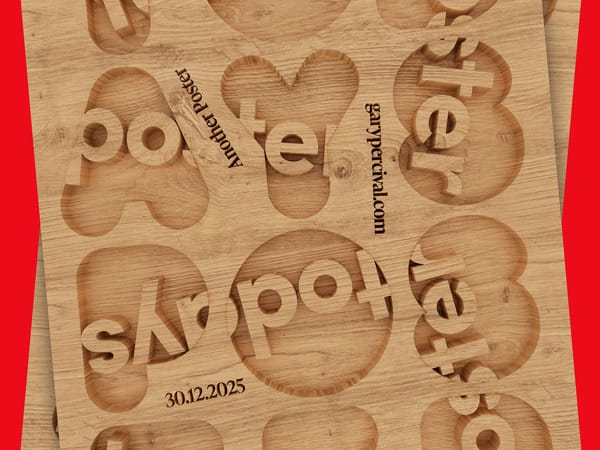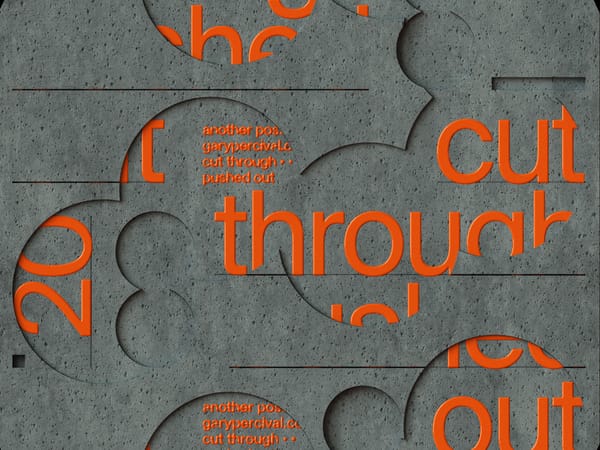Fast, Flexible, and Wrong—and Still Winning
“Being wrong isn’t wasted—it’s rehearsal for being right.”

In creative work, the scariest mistake isn’t being wrong.
It’s waiting so long to avoid being wrong that you never move at all.
We hesitate, polish, and second-guess. We keep ideas in drafts, files, or sketchbooks because we want them safe, untouched. A poster left unpublished, a pitch deck endlessly “final-final-v3”, and a logo revision that never leaves your desktop.
But safe doesn’t win.
The creatives who last aren’t the ones who avoid mistakes. They’re the ones who move, adapt, and treat being wrong as fuel.
Why Speed Matters More Than Perfection
Speed in creative work isn’t about rushing or cutting corners. It’s about closing the gap between having an idea and testing it in reality.
That could mean mocking up a poster in an afternoon instead of agonising for weeks. Sharing a rough type experiment online instead of hiding it until it’s “perfect”. Draughting an email pitch in 15 minutes instead of over-editing it into silence.
A quick start gives you:
- Early feedback—you’ll see what works (and what doesn’t) before you’ve invested too much.
- More cycles of learning—the faster you move, the more chances you have to refine.
- Momentum—progress fuels energy, while long delays drain it.
Moving slowly might feel safer, but it often leaves you with something polished and irrelevant. In competitive fields, hesitation often costs more than mistakes.
Flexibility as a Creative Advantage
Flexibility is often mistaken for a lack of direction. In reality, it’s the ability to adapt without losing your focus.
Designers and freelancers live in shifting environments:
- A client suddenly pivots the brief.
- A trend rises overnight and makes yesterday’s concept look stale.
- A tool update changes how you work.
Flexibility allows you to:
- Reframe midstream without scrapping everything.
- Shift priorities when new opportunities appear.
- Respond quickly to obstacles without losing momentum.
Without flexibility, speed becomes recklessness. You’re fast, but only in one direction—even if it’s the wrong one.
The Productive Side of Being Wrong
Being wrong has a terrible reputation. Many creatives treat it as something to avoid at all costs. But wrong isn’t the problem—staying wrong is.
When you work fast and stay flexible, wrong turns are:
- Cheaper—you haven’t sunk months into the wrong path.
- Simpler to fix—you’re used to course corrections.
- More instructive—you gain real-world lessons, not abstract guesses.
That unused layout? It sharpened your instincts.
That scrapped poster? It taught you what doesn’t resonate.
That lost client? It revealed the kind of work you don’t want more of.
Being wrong isn’t wasted—it’s rehearsal for being right.
The Cycle That Wins
The real power comes from the cycle:
1. Fast—act quickly on the information you have.
2. Flexible—adapt when things change.
3. Wrong—extract lessons and move forward.
It’s this rhythm—test, adjust, learn—that compounds into progress. While others hesitate, you’re already further down the path.
Why Creatives Resist This Approach
If “fast, flexible, and wrong” works so well, why do so many resist it?
- Perfectionism—the need to make everything flawless before showing it.
- Ego attachment—confusing being wrong with being untalented.
- Fear of wasted effort—focusing on sunk costs instead of better directions.
- Rigid planning—writing detailed roadmaps that collapse when reality shifts.
These habits feel protective, but they make mistakes more costly and slow your growth.
Lowering the Cost of Being Wrong
The secret is reducing the consequences of mistakes. When wrong becomes less expensive, it stops being so scary.
- Test small, scale later. Rough sketch before final artwork. Simple prototype before full build.
- Design for reversibility. Make choices you can roll back. Only lock in the irreversible when you’re sure.
- Separate identity from outcome. A failed concept says nothing about your worth—it only reflects conditions at the time.
Lower the cost of being wrong, and suddenly speed and flexibility feel natural.
The Feedback Advantage
Moving fast gives you more opportunities for feedback.
More feedback means:
- Problems are caught earlier.
- Adjustments are smaller and less painful.
- Learning compounds quickly.
When you move slowly, each decision carries more weight. Pressure builds, hesitation creeps in, and wrong turns become expensive. Fast, flexible work spreads risk across many small bets instead of a few giant ones.
Adaptability as a Career Skill
This cycle doesn’t just apply to projects—it applies to careers.
Freelancers, designers, and creatives face shifting markets: tools evolve, trends change, and client needs shift. If you can’t adapt, you risk becoming irrelevant.
The creatives who thrive aren’t the ones who never stumble. They’re the ones who keep moving, pivot when they must, and learn so quickly that being wrong becomes part of their edge.
Signs You’re Playing Too Safe
You might be resisting the cycle if:
- You delay publishing work until it feels “finished”.
- You stick to a plan even when results are poor.
- You overanalyse instead of deciding quickly.
- You treat adjustments as failures instead of refinements.
If these sound familiar, you’re trading the possibility of being wrong for the certainty of being slow.
Building the Fast, Flexible Mindset
To make this a habit:
- Act before you feel ready. Readiness is usually a byproduct of action.
- Decide faster. For low-stakes choices, set a time limit—minutes or hours, not days.
- Normalise mid-course changes. Treat adjustments as expected, not exceptional.
- Review regularly. Frequent check-ins help you spot when to persist and when to pivot.
Balancing Speed With Standards
Being fast doesn’t mean lowering your standards—it means sequencing them differently.
High standards should apply to the final product, not the first draft. Early stages are about building the frame quickly so you can see what works. If it’s wrong, you adjust before investing heavily.
Think of it as sketching the structure before perfecting the details.
Making Wrong Useful
Every wrong decision contains something worth keeping:
- A lesson—what didn’t work, and why.
- A fragment—a colour choice, a phrase, a layout worth carrying forward.
- A sharper instinct—a better sense of where to go next.
Wrong is only wasted when you ignore it.
The difference isn’t between right and wrong—it’s between those who wait and those who move.
Closing Perspective
In a world where conditions shift quickly, slow and rigid loses to fast and adaptable—even if the adaptable get things wrong more often.
The winning formula isn’t perfection. It’s momentum, adaptability, and recovery.
Fast gets you in the game.
Flexibility keeps you in it.
Being wrong teaches you how to win it.
Combine all three, and you’ll discover that progress—not perfection—is your real competitive advantage.



